Door lock with handle and latch: design options and principle of operation
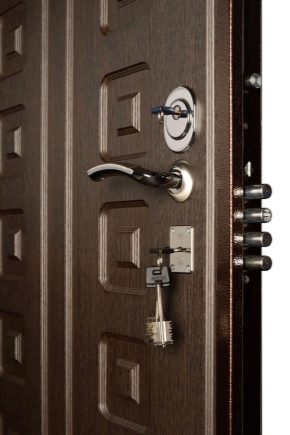
Door locks with handles and latches are a popular type of locking mechanism and are widely used on entrance and interior doors. The use of a latch significantly increases the functionality of the lock structure, and the presence of a handle makes its use easy and convenient.
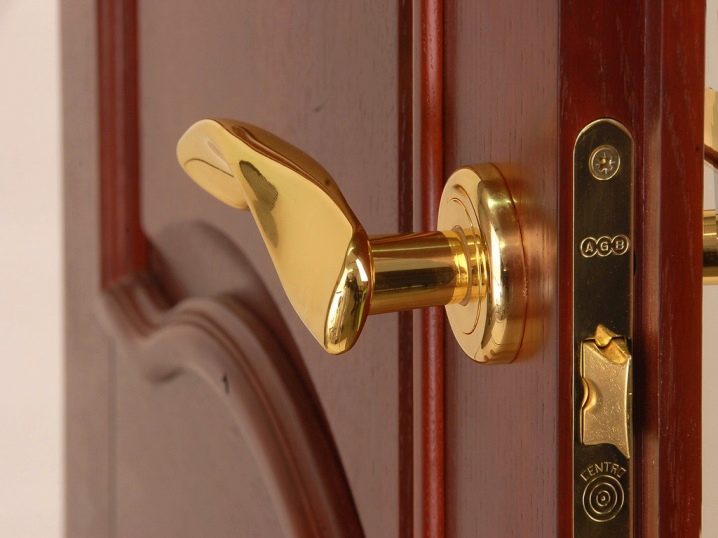
Construction characteristics
Structurally, the lock is a complex mechanical device consisting of a body, a locking mechanism, a latch, a blocker, a push or rotary handle and a decorative strip, which in some models is replaced by separate sockets. A feature of devices with latches is the ability to use them with any type of locking mechanism, including lever, cylinder, magnetic, electronic and electromechanical models. In addition, the locking structures can be equipped with a coded device or have a combined design.
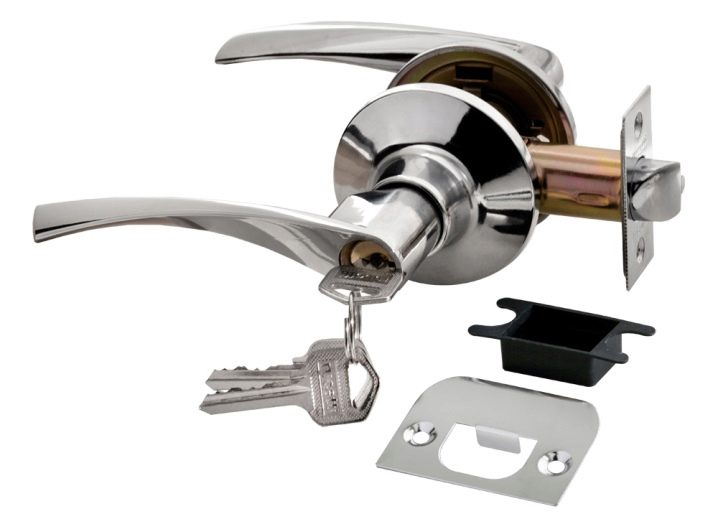
The most suitable device for installation on a metal entrance door is a lever type lock. The mechanism of such a lock consists of figured plates, which have a large number of combinations that form a secret pin. The number of teeth on the key bit determines the number of leveler plates inside the device: their number is always one less than the number of teeth. Lever locks are characterized by a long service life and high burglary resistance.



Cylinder models are also often installed in locks equipped with latches and handles. Their mechanism is presented in the form of a cylinder-larva with figured elements or disks placed inside. The door is opened when the recesses on the key coincide with the recesses on the figured elements. Such devices are also quite reliable and convenient to use, and the latch installed in them often plays the role of a locking bolt. The slamming of the latch in such designs is due to its beveled shape. The tongue compresses the spring and quickly enters the groove, after which the spring expands and returns the latch to its original position.



Door locks equipped with a handle and a latch can have one-piece design, in which both the latch and the locking mechanism are located in a single block and are closed by a common decorative strip. Also, the mechanisms can be made in the form of separate devices, each equipped with its own decorative rosette. The installation of such locks is carried out by cutting them into the door leaf, which contributes to the maximum preservation of the external appearance of the door and an increase in burglary resistance.

Device options
Locks with handles and latches are presented in two groups: simple locking mechanisms for interior doors and serious options with a high security class for entrance groups.


Interior models
Locks designed for installation on interior doors do not have such serious safety requirements. Such structures, as a rule, are installed in protected premises, and the locking device is more of a preventive nature than protects property from intruders. The main purpose of interior locks in an apartment is a conditional fencing of personal space, preventing drafts and locking the premises from small children or pets.



Structurally, mortise interior locks differ from each other in the type of latch. The most popular and widespread option is the latch, or, as it is also called, "dog". The latch is made of steel, aluminum or tsamak and has a beveled shape in one direction. The action of the latch to close occurs when the door is deliberately slammed or a draft. The latch is opened by lowering the push handle or turning the knob around its axis.
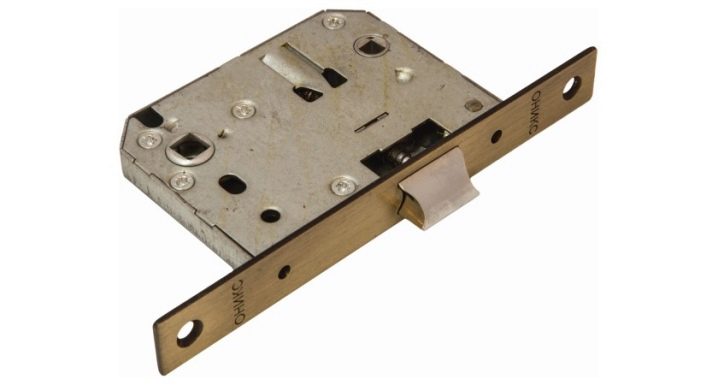
Locks equipped with latch latches often have a latch that allows the tongue to be forcibly pulled into the device or locked in the closed position. Sometimes the locks are equipped with two tongues, one of which works independently of the bolt latch, and the second is combined with it into a single mechanism. The handles that control the stroke of the latch latches can have both single and paired versions and are more often located above the keyhole.
The magnetic latch is an equally popular type and is most often used in office premises with a large flow of visitors. Due to its soft running and quiet operation, this lock does not irritate employees and does not distract them from their work. In addition, many magnets have significant gravitational forces and begin to operate even when the door is not fully closed. Acting in this way as a door closer, magnetic latches relieve employees of the need to get up and close a door left ajar by one of the visitors.


The remote operation of the magnetic latch significantly reduces the heat loss in the room in winter and keeps the air conditioners cool in the summer months. In addition, a tightly closed door does not allow extraneous noise to enter the room and does not allow to hear what is happening in the office from the corridor. More sophisticated magnetic mechanisms are able to pull the bolt into the hole of the striker plate, into which the ferrite core is mounted. It becomes impossible to open such a door from the outside. However, it is worth lowering the lever handle from the inside, and the bolt will quickly hide in the locking mechanism.
Roller latches are also commonly used in interior door locks. The tongue of such devices has a cylindrical or beveled shape on both sides and can be placed both in the locking mechanism itself and on the striker of the door frame. When the door is closed, it enters the socket and is held in it by means of an internal spring. The roller latch opens quite easily, for this you need to press the handle and slightly push the door. Such devices are not capable of full-fledged locking, therefore, they are not installed in interior doors so often. However, for swing blades that swing in both directions, roller latches are quite suitable.

For entrance doors
Unlike interior models, such devices have special requirements for security and burglary resistance. However, given the design capabilities of such mechanisms, their use as the main locking device is not very effective. Latch locks are more suitable as a useful addition to the main lock, however, provided that the lockable room does not require increased protection, they can be quite used as the main one.
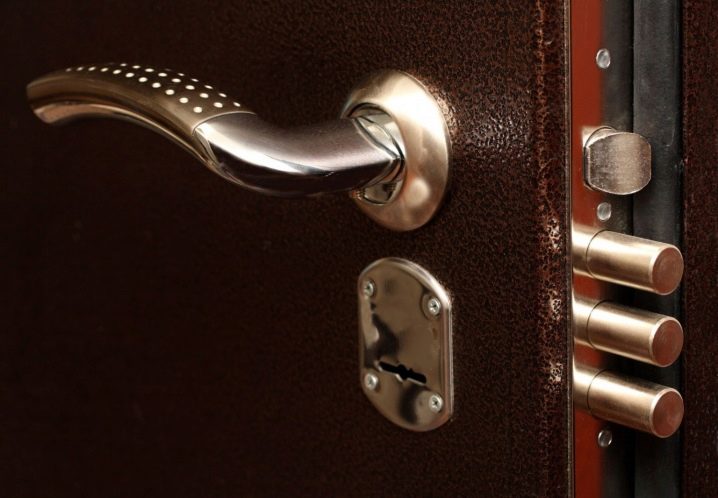
The locks for the entrance groups use latch and magnetic latches, which are controlled both using push handles and rotary knobs, as well as by means of electronic and remote control methods. In locks with electromechanical, coded and electronic mechanisms, it is the latch that plays the role of a locking bolt. From the outside, it can be opened using an electronic key, entering the required combination or using the remote control, and from the room - by pressing a button or handle.
However, electronic and electromechanical locks are not used for apartment doors. Such models are installed on driveways, entrance gates or gates. The explanation is simple: both models operate on electricity, and when it is turned off, the circuit breaks and the latch opens. But not all electromechanical models work on this principle. There are reverse-acting locks in which the latch is opened only when electricity is supplied, and the rest of the time the door remains closed. Such a narrow-profile version is used at facilities that require increased protection, since the door will be securely locked even in the event of a power outage.


How to choose?
When buying a lock with a latch and a handle, you should first of all proceed from the functional purpose of the door. One of the main criteria should be the material of manufacture of the device. Internal locking mechanisms are mostly made of steel, and as for other structural elements, options are possible here. Lever handles and knobs are often made from aluminum or zamak. If you choose between these two options, then the second is preferable. TsAM (Tsamak) is an alloy of zinc, aluminum and copper.


The material has incorporated the best performance properties of these metals and is characterized by high strength and long service life. In addition, zamak locks have good moisture resistance and are insensitive to extreme temperatures. This allows them to be installed in the interior of any purpose and on the door leaves of the entrance groups. However, for heavy iron doors, it is better to opt for an all-steel structure. Such products often have a chrome-plated surface, due to which they perfectly fit into any modern interior and are in harmony with the design of most doors.
In addition to the material itself, you must also pay attention to the manufacturer. Thus, the products of the Finnish company Abloy are well known in Russia. The company is engaged in the production of locks with lever and rotary handles, which are distinguished by good quality locking mechanisms and an attractive appearance. The assortment of the company is presented both by products of a high price category and by budget models.



The products of the Chinese company Morelli have proven themselves well. The company specializes in the production of models from TsAM, intended for both indoor and outdoor use. The locks of the Spanish company Archie and the Italian company Colombo have a lot of positive reviews. The products of the enterprises are distinguished by the durability of the locking mechanism, as well as the stylish appearance of the linings and handles.


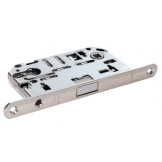

Installation recommendations
Installation of a door lock with a handle and a latch in a metal door should be carried out using a professional tool and with certain skills, so it is better to entrust the insert to specialists. However, you can handle the installation of an interroom device yourself. Installation includes several stages.
First you need to mark the place for the castle. The optimal height for its installation is considered to be 95 cm. After applying the markings, you should start drilling the hole for the handle. Moreover, it is not recommended to drill a hole through on one side. It will be more correct to drill until the mark from the drill appears on the back side, after which you need to pull the drill out of the hole and start drilling from the back side. This will preserve the decorative finish of the door and make the opening more tidy.


Then you can start drilling the holes for the bolt and the latch at the end of the canvas. It is necessary to drill with a drill-pen, carefully deepening and trying not to come close to the edges of the canvas.After the hole has been drilled, it is necessary to attach a lock to the door and outline the contour of the mounting plate. Then, along the delineated area, using a chisel, you need to make a recess, the thickness of which should correspond to the thickness of the mounting plate, after which you can start installing the lock.


After the lock is installed and secured with self-tapping screws, the handle should be installed. To do this, remove one handle and insert the unassembled part into the hole on the back of the blade. Then, from the inside of the door, you need to reinstall the removed handle and fasten both parts with the screws that come with the kit. Next, a decorative strip is installed and markings are made for the crossbars and a latch on the box.

To do this, smear the ends of the crossbars and the edge of the latch with toothpaste, close the door and try to open the lock. Then you need to carefully close the lock, pull in the latch with the handle and open the door. If everything is done correctly, then traces of crossbars and latches will remain on the door frame striker. In their place, you need to form holes and screw on top of the protective strip. As you can see, a door lock with a handle and a latch reliably protects the room and makes your stay in it comfortable and safe.

How to install a lock with a handle and a latch with your own hands, you will learn from the video.













The comment was sent successfully.